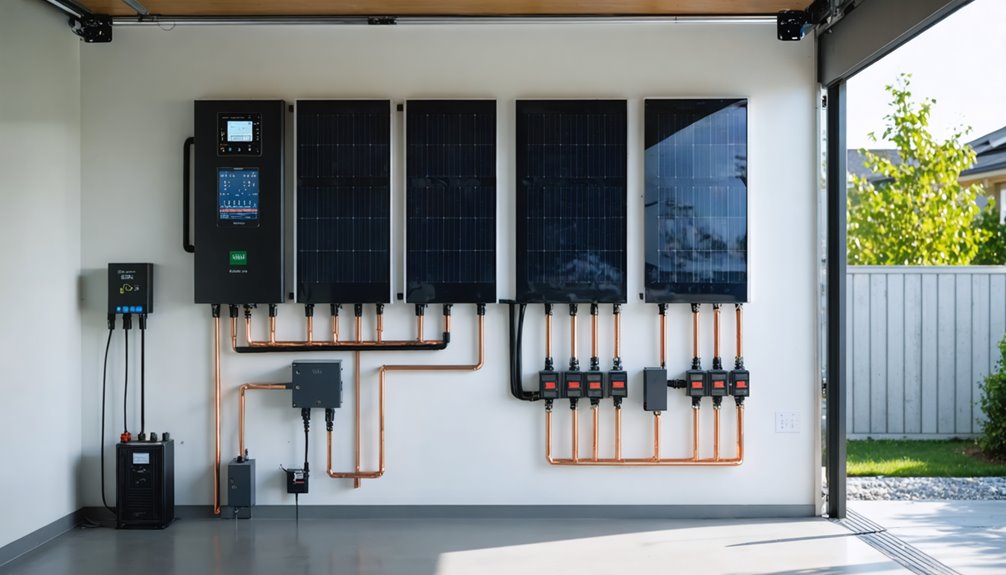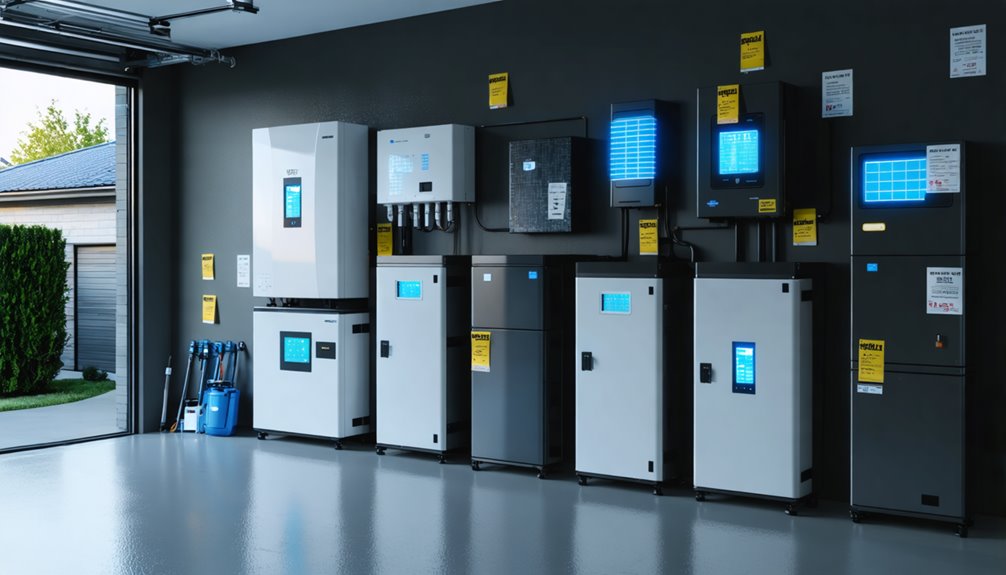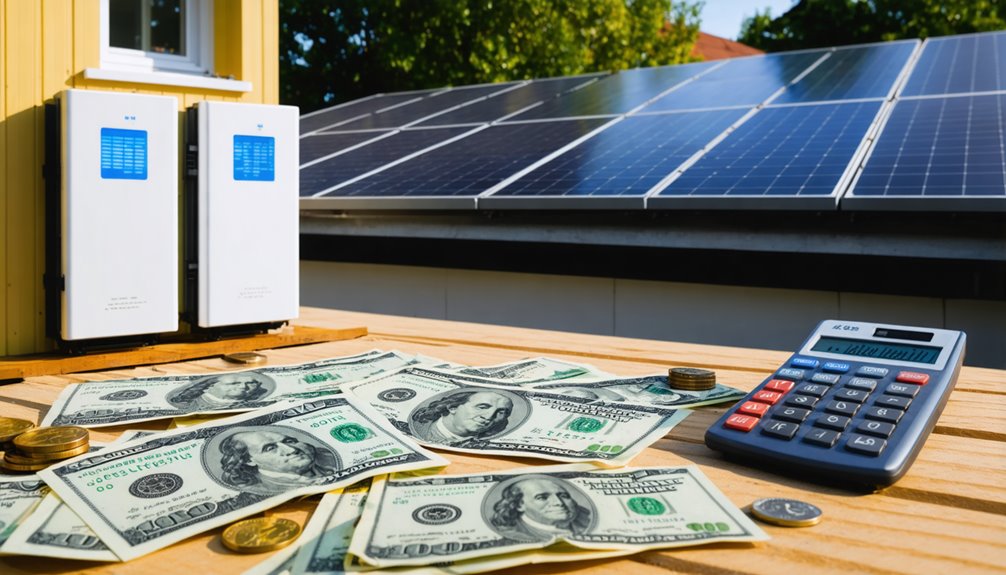If you’re considering solar batteries for your home in 2025, you’ll face prices ranging from $6,000 to $18,000 for complete installation. That’s about $1,300 per kilowatt-hour before tax credits kick in. Popular models like Tesla’s Powerwall cost around $9,200. But here’s what most homeowners don’t realize about these prices—several hidden factors can dramatically change your final bill.
Average Solar Battery Costs in 2025
When you’re looking at solar battery costs in 2025, you’ll find prices ranging from $6,000 to $18,000 for a complete installation. The average cost runs about $1,300 per kWh before incentives. Your energy needs and storage capacity requirements will determine the final battery system cost.
Here’s good news: the federal tax credit cuts 30% off your installation cost. That brings the price down to roughly $1,000 per kWh. A standard 13.5 kWh system costs around $13,500 after applying this credit.
Most homeowners choose Lithium Iron Phosphate batteries for their reliability and safety. Smaller 5 kWh systems start at $6,500, while larger 40 kWh units can reach $52,000. Popular models include Tesla’s Powerwall at $9,200 and LG Chem Prime at $9,500. When deciding if solar batteries are worthwhile, consider factors like increased home value and protection against rising energy costs, as these can impact your return on investment.
Solar Battery Cost Breakdown: Equipment Vs Installation
The battery unit makes up the biggest chunk of your solar battery system’s price tag. You’ll spend $6,000 to $12,000 on the battery alone. That’s more than half of your total solar battery costs.
Installation labor adds another $1,000 to $2,000 to your bill. The inverter cost runs about $1,000 to $1,500 if you need one separately. These solar batteries also need wiring and monitoring systems, which cost $200 to $500 more.
Your cost breakdown doesn’t end after installation. You’ll pay $150 to $300 yearly for maintenance costs. When you add everything up, you’re looking at $6,000 to $23,000 total. The additional costs might seem small compared to the battery unit, but they still matter to your budget. Emerging trends like vehicle-to-home integration offer new possibilities for making efficient use of solar and battery systems.
Cost per Kwh: Understanding Battery Pricing
Breaking down solar battery costs gets easier once you understand price per kilowatt-hour (kWh). You’ll find solar batteries cost about $1,300 per kWh before incentives. Federal tax credits can reduce this to $1,000 per kWh.
Battery prices stay consistent across sizes. A 5 kWh energy storage system costs $6,500, while a 40 kWh system runs $52,000. Both equal $1,300 per kWh. Installation costs vary by location and complexity. An average 11.4 kWh battery costs around $9,041 installed.
Lithium-ion batteries cost more upfront but offer better efficiency. Lead-acid options cost less initially but don’t last as long. Long-term value depends on the battery’s depth of discharge and lifespan, not just the initial price tag. Solar batteries also enable continuous operation for businesses, ensuring energy reliability and stability crucial for uninterrupted services.
Factors That Impact Solar Battery Prices

If you’re shopping for solar batteries, you’ll notice prices vary widely based on several key factors. The cost of solar batteries depends heavily on system size. Larger battery storage systems up to 40 kWh cost more overall but less per kWh. Your choice between DC and AC batteries affects pricing too. DC batteries cost less, while AC batteries offer better flexibility. Installation costs change based on labor costs and how complex your setup is. Local market demand also drives prices up or down. Recent tariffs and inflation have pushed prices higher. But there’s good news. Financial incentives help offset these costs. You can get a 30% federal tax credit. Some states offer additional rebates that make solar batteries more affordable for homeowners. Additionally, understanding battery chemistry types is crucial as they impact the efficiency, lifespan, and overall cost of the solar battery system.
Federal Tax Credits and Local Incentives
You can save thousands of dollars on solar battery installations through government programs and utility company incentives. The federal government offers a 30% tax credit that covers installation costs through December 31, 2025, while states like California and Maryland provide additional rebates. Your local utility company might also pay you yearly for storing energy during high-demand periods.
Federal 30% Tax Credit
One major financial incentive makes solar batteries more affordable right now. The federal solar tax credit lets you deduct 30% of installation costs from your federal taxes. This deduction applies to renewable energy systems, including battery installations, through December 31, 2025.
Here’s how it works: If you spend $17,550 on a battery, you’ll save about $5,265 in tax savings. That’s a significant reduction in upfront costs.
You can also find local incentives that stack with the federal credit. California offers the Self-Generation Incentive Program. Many utility companies provide rebates too. These programs vary by state and provider.
The deadline matters. After 2025, new installations won’t qualify for the federal credit. Many homeowners are checking their state’s programs now to maximize their savings before time runs out.
State Rebate Programs
Beyond the federal tax credit, many states offer their own rebate programs to help residents save money on solar batteries. State-specific rebate programs can cut your upfront costs markedly. California’s SGIP provides substantial incentives for battery installations. Maryland and Massachusetts have created their own programs too.
| State | Program Name | Potential Savings |
|---|---|---|
| California | SGIP | Up to $1,000/kWh |
| Maryland | Energy Storage Tax Credit | 30% of costs |
| Massachusetts | SMART Program | Performance-based incentives |
| North Carolina | Duke PowerPair | $0.36/kWh rebate |
| New York | NY-Sun | Up to $250/kWh |
Local utilities also offer incentives during peak demand times. These programs vary by region, so you’ll find different opportunities depending on where you live. When combined with the federal tax credit, state programs can dramatically improve your return on investment for a solar battery system.
Utility Incentive Options
While state programs offer valuable savings, utility companies across the nation have created their own incentive options that stack with federal tax credits. You’ll find these utility incentive programs can greatly reduce upfront costs for residential battery systems.
The federal tax credit still covers 30% of your solar battery installation costs through 2025. For a $17,550 system, that’s about $5,265 in savings. Remember, your battery needs at least 3 kWh capacity to qualify.
Many utility companies now pay homeowners for energy stored during peak demand times. These payments work alongside federal benefits. In California, you can combine utility rebates with local programs like SGIP. This stacking approach makes solar batteries more affordable than ever before.
Financing Options for Solar Battery Systems
How can you afford a solar battery system without paying thousands upfront? You’ve got several financing options that work like car or home loans. Many solar battery systems now offer zero down payment plans.
Here’s what financing typically looks like:
| Loan Term | Monthly Payment | Total Cost |
|---|---|---|
| 5 years | $650-850 | $39,000-51,000 |
| 10 years | $350-450 | $42,000-54,000 |
| 20 years | $200-250 | $48,000-60,000 |
Interest rates affect your total payment considerably. That 7.9 kW system with a 12.5 kWh battery? It’ll cost nearly $47,000 over 20 years with financing.
You’ll find specialized financing products designed for solar. These often beat traditional loans. Don’t forget the 30% federal tax credit available until December 31, 2025. State and local programs offer additional rebates to reduce your upfront cost. Compare repayment periods carefully before choosing.
Popular Solar Battery Models and Their Prices

When you’re shopping for solar batteries in 2025, you’ll find several popular models at different price points. The Tesla Powerwall leads the market with solar battery installations costing $15,400 for the Powerwall 3. The Enphase IQ 10 runs about $10,000, while Generac PWRcell offers budget-friendly solar battery storage at $8,000 installed.
The LG Chem Prime lithium-ion battery costs around $9,500. SolarEdge’s model sits at $9,000. If you’re considering cheaper alternatives, lead-acid batteries range from $1,000 to $3,000. However, they won’t last as long as lithium-ion options and need more maintenance.
Battery prices vary based on capacity and installation complexity. The Tesla Powerwall 2 ranges from $8,750 to $15,000 installed, showing how costs can differ for the same model.
Long-Term Savings Vs Upfront Investment
You’ll need to calculate how long it takes to earn back your solar battery investment through energy savings. Most homeowners find their payback period extends by 5 to 10 years when they add a battery to their solar system. Financial experts use different methods to figure out if you’ll make money over time, including comparing your total savings against the upfront costs minus any tax credits. It’s important to consider factors such as daily energy consumption and battery capacity when estimating how much you might save over time.
Payback Period Analysis
Solar batteries require a significant upfront investment that affects when homeowners break even on their purchase. The costs of solar typically extend the payback period by 5 to 10 years. You’ll need to evaluate battery incentives and local installers’ prices when calculating financial returns.
Areas with strong net metering see slower returns since you can sell excess energy storage back to the grid. Without favorable policies, you might save more by storing energy for peak usage times. This makes energy storage more valuable in certain locations.
When determining if solar batteries are worth the investment, you’ll factor in maintenance costs of $150 to $300 yearly. The payback period depends on your consumption patterns, utility rates, and available incentives.
ROI Calculation Methods
The return on investment for solar batteries depends on comparing your total upfront costs against long-term energy savings. You’ll typically spend $6,000 to $23,000 for solar energy storage systems. The 30% federal tax credit can cut these upfront costs by about $4,500, making the roi calculation more favorable.
Your energy savings depend on several factors. Local electricity rates play a big role in determining potential savings. If you’re on time-of-use rates, you’ll save more by using stored power during expensive peak hours. Net metering policies in your area also affect returns.
The cost of battery storage per kilowatt-hour helps you understand the investment’s value. Most homeowners see returns within 5 to 10 years, though some prioritize backup power over immediate financial gains.
Installation Considerations and Additional Costs
When you’re adding solar batteries to your home, installation costs can add $1,000 to $2,000 to your total bill. The amount depends on how complex your solar battery system is and how many batteries you’re installing. You’ll likely need additional equipment too. Inverters can cost between $1,000 and $1,500 if they’re not already part of your setup. Monitoring systems and wiring add another $200 to $500 to your expenses. Your location matters. Local labor rates vary widely across the country. You might also need electrical work or permits, which increase total installation costs. The battery type you choose affects the price too. Different brands have different technical requirements. Some need special installation techniques that cost more. Homeowners considering these systems should be aware that solar battery storage can offer backup power during outages and help reduce electricity bills.
Is a Solar Battery Worth It for Your Home?
You’ll need to contemplate three main factors when deciding if a solar battery makes sense for your home. The financial return depends on your local electricity rates and whether your utility offers good net metering policies. Your need for backup power during outages and desire for energy independence also play major roles in determining the battery’s value. It’s important to consider factors that affect battery longevity, such as depth of discharge, temperature extremes, and maintenance practices, to ensure your solar battery investment delivers the longest possible service life.
Financial Return on Investment
After calculating the costs and savings, most homeowners find that solar batteries take 5 to 10 years to pay for themselves. The financial return on investment depends on your location and energy goals. You’ll see better savings in areas without net metering policies. That’s because your solar battery can store energy when rates are low and use it when they’re high.
The 30% federal tax credits help reduce installation costs until 2025. This makes the upfront cost more manageable. You’ll need to assess how often power outages happen in your area. Some homeowners say the peace of mind from backup power makes it worth the cost, even with a longer payback period.
Backup Power Value Assessment
Many homeowners wonder if solar batteries are worth the investment, especially when considering backup power needs. The average cost for an installed solar battery runs around $9,041 in 2025. That’s a significant expense, but you’ll gain energy independence and reliable backup during outages.
The financial rationale becomes clearer when you factor in the 30% federal tax credit available through December 31, 2025. This credit reduces your actual cost of a solar system considerably.
Is a solar battery worth it? For homes in areas with unreliable power grids, the backup power alone can justify the investment. You’ll have peace of mind knowing essential appliances will keep running during blackouts. Plus, if you’re dealing with time-of-use rates, you can store cheap energy and use it when prices peak.
Personal Energy Independence Goals
When homeowners think about energy independence, they’re often considering freedom from power outages and rising electricity costs. Solar batteries let you store extra solar power for later use. This backup power keeps essential systems running during blackouts.
Your energy goals determine if these batteries make sense. Some homeowners want protection from outages. Others seek long-term savings through stored energy during expensive peak hours. Installation costs range from $6,000 to $23,000. The federal tax credit covers 30% of expenses.
Popular options like the Tesla Powerwall last 10-15 years. They’re especially valuable in areas with frequent outages or poor net metering policies. Each homeowner’s situation differs. Your location, utility rates, and personal needs shape whether solar batteries fit your independence objectives.
Conclusion
You’ll find solar batteries in 2025 cost between $6,000 and $18,000 for complete installation. That’s about $1,300 per kWh before tax credits. Popular models like Tesla’s Powerwall run around $9,200. Federal incentives can lower your final price. Your actual cost depends on where you live, local labor rates, and which technology you choose. Many homeowners are weighing these upfront costs against potential long-term savings on their electric bills.


